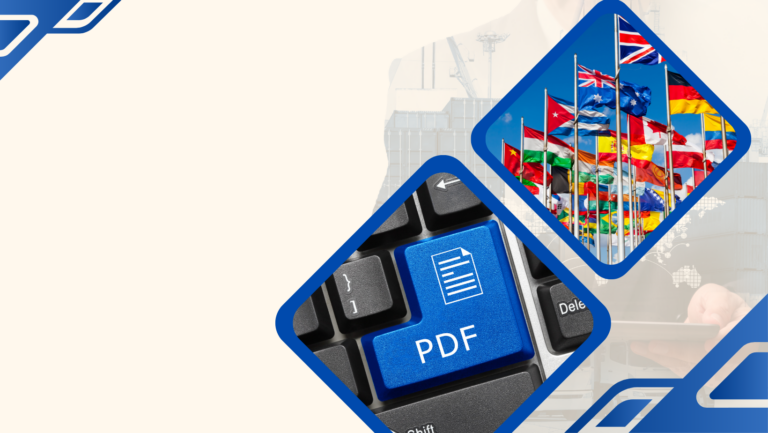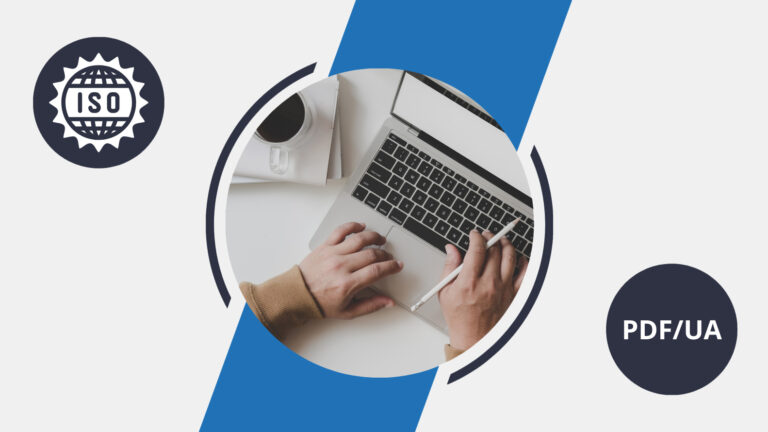This is the golden rule: understand digital accessibility standards, their differences, benefits, and impact on your content’s user experience. To help you implement them, our experts have delved deep into the subject. So we’ve created a comprehensive guide to cut through the confusion about the standards that apply to the design of accessible digital tools and services.
This articles focuses on office documents, especially PDFs. What are the similarities and differences between the standards? Which guidelines should be followed? Find the answers in our comparative guide to WCAG and PDF/UA.
Which standard should I use?
For web pages, use the WCAG standard. For creating documents and PDFs, choose the PDF/UA standards.
While these standards differ, they all aim to make digital content accessible to everyone. So it’s important to understand these subtle differences. Following these guidelines will help us build a more inclusive online space for everyone.
Digital accessibility standards: understanding the basics
Reminder: What is accessibility? And why is it important?
Digital accessibility ensures equal access to information, services and opportunities regardless of a user’s ability.
It is fundamental human right, essential for social inclusion and participation. Accessible technology and information enable people with disabilities to participate fully in society, especially in education, employment and civic engagement.
Digital accessibility is also a major challenge to ensure an inclusive user experience tailored to everyone. It benefits everyone, including elderly people.
Various standards and regulations have been introduced around the world to help achieve this.
The different accessibility standards: which standard for which communication medium?
There are several standards to ensure the accessibility of products and services to people with disabilities. These include WCAG and PDF/UA.
Although these standards achieve similar accessibility goals, it is important to understand their differences so you can choose the appropriate standard.
ABOUT WCAG
The Web Content Accessibility Guidelines (WCAG) are international standards for websites, mobile applications and HTML documents.
There are three levels of compliance: A, AA and AAA. Each level corresponds to a set of specific success sub-criteria that must be applied to achieve the required level of compliance. Level A is the basic level, while level AAA is the highest level of compliance.
Success criteria include the ability to navigate the site using only the keyboard, the inclusion of text alternatives to images, and the creation of content that is easy to read and understand.
| In France, our benchmark is the RGAA, a specific piece of legislation that sets out the requirements for digital accessibility. Inspired by WCAG, its ultimate goal, like the international standard, is to ensure equal access to digital content for all users, regardless of their abilities. |
PDF/UA
The Portable Document Format/Universal Accessibility (PDF/UA) standard, published in July 2012 as ISO 14289, provides guidelines for creating accessible PDF documents.
The PDF format is widely used in everyday life, especially in the workplace, because it is compatible with all systems. It preserves the textual and non-textual elements of documents.
However, PDF files are not always accessible to everyone, especially people with disabilities. Therefore, it is important to have consistent and applicable rules to facilitate the implementation of accessible PDFs.
With the PDF/UA standard, everyone should be able to access the content of PDF documents, regardless of disability, whether visual, auditory or cognitive.
What do the WCAG and PDF/UA accessibility standards have in common?
The WCAG and PDF/UA standards share a common goal: making digital content accessible to everyone, including people with disabilities who use assistive technologies.
There are similarities between the two standards: for example, tags <H1> et <H2> represent Level 1 and Level 2 titles in both standards. However, they are not identical in terms of the tags used to structure content. In HTML, bullet lists use tag <UL> and numbered lists. <OL> In PDF, a single tag is used for both <L>.
What are the differences between the two accessibility standards?
WCAGs are primarily concerned with web content and do not cover digital documents. In contrast, PDF/UA focuses specifically on the accessibility of PDF documents.
The differences are
Number of tags
HTML 5, a language widely used for web content, offers almost 200 tags that are used to present, interpret and render online information. In comparison, the PDF standard has fewer than 30 specific tags designed to mark up and interpret the content of PDF documents.
Guidelines to follow
To ensure optimal accessibility, the international WCAG standard provides more than 50 checkpoints, success criteria and guidelines to follow. The PDF/UA standard includes 31 checkpoints to ensure that PDF documents are accessible.
| The different organisations that develop, validate and publish the WCAG and PDF/UA standards are For WCAG: the WAI (Web Accessibility Initiative), part of the W3C (World Wide Web Consortium). The WCAG has been validated and published by ISO as ISO/IEC 40500:2012. The PDF/UA standard was developed and written by PDFA (the PDF Association) and approved and published by ISO as ISO 14289-1. |
Throughout this comparative guide, we have seen the real differences between WCAG and PDF/UA. Understanding and implementing the specific features of each format will help you to ensure accessibility.
The rest is up to you.












